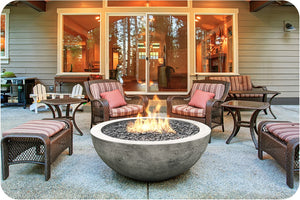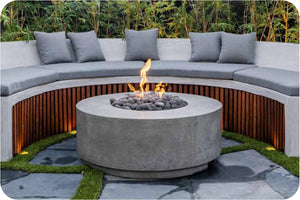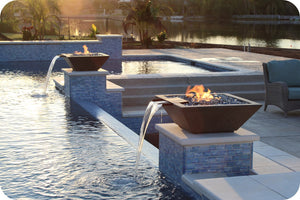When it comes to creating the perfect backyard oasis, one question almost always comes up: Gas vs. Wood Fire Pits—which one is better?
Both options have their advantages. A wood-burning fire pit offers the classic crackling campfire feel, while a gas fire pit delivers convenience and clean-burning flames at the push of a button.
In this guide, we’ll compare gas and wood fire pits in detail, outline their pros and cons, and showcase some of our most popular models at Freedom Fire Pits—so you can make the best choice for your backyard.
Gas Fire Pits
What is a Gas Fire Pit?
A gas fire pit uses propane or natural gas to create controlled flames. They’re easy to ignite, adjustable, and burn cleanly without ash or smoke.
Pros of Gas Fire Pits
-
Instant Ignition – Light your fire with a push-button or electronic starter.
-
Low Maintenance – No wood chopping, ash cleanup, or smoke to deal with.
-
Consistent Flames – Steady, controlled flame levels for safety and ambiance.
-
Modern Aesthetic – Sleek, contemporary designs that elevate backyard spaces.
-
Safe & Family-Friendly – Fewer sparks and no flying embers.
Cons of Gas Fire Pits
-
Higher Initial Cost – Gas models and installations can be more expensive.
-
Fuel Source Limitations – Requires propane tanks or natural gas line.
-
No Campfire Aroma – You miss out on the smoky scent of real burning wood.
Featured Gas Fire Pits from Freedom Fire Pits
-
Prism Hardscapes Tavola 4 Concrete Fire Table
-
Sleek modern fire table with ample surface space—perfect for entertaining.
-
-
The Freedom Collection Acadia Concrete Fire Table
-
A luxury handcrafted piece with bold design—ideal as a backyard centerpiece.
-
-
The Outdoor Plus Avalon Fire Pit (GFRC Concrete)
-
Durable GFRC construction with sleek lines for a high-end modern look.
-
Wood Fire Pits
What is a Wood Fire Pit?
A wood fire pit is the classic choice—burning real logs for warmth, sound, and aroma. They’re perfect for homeowners who love the rustic charm of a natural flame.
Pros of Wood Fire Pits
-
Authentic Experience – Crackling logs, natural heat, and smoky aroma.
-
Lower Initial Cost – Wood fire pits are often more affordable upfront.
-
No Fuel Lines Needed – Just add logs and you’re ready to go.
-
Great for Cooking – Roast marshmallows or cook over an open flame.
Cons of Wood Fire Pits
-
More Cleanup – Ash, soot, and smoke require regular maintenance.
-
Less Control – Flame intensity depends on log size and arrangement.
-
Smoke & Sparks – Can be messy and bothersome in windy conditions.
-
Wood Storage – Requires keeping a dry supply of firewood.
Featured Wood-Compatible Options
While many of Freedom Fire Pits’ models are designed for gas, wood-burning fire pits can be an option depending on your setup. For example:
-
Prism Hardscapes Lombard Pedestal Concrete Water Bowl – Elegant design for smaller spaces.
-
Tavola 8 Fire Pit Cover – Essential protection for both wood and gas fire pits.
Gas vs. Wood Fire Pits: Quick Comparison
| Feature | Gas Fire Pits | Wood Fire Pits |
|---|---|---|
| Ease of Use | Instant ignition | Manual setup & lighting |
| Maintenance | Low (no ash/smoke) | High (cleaning required) |
| Cost | Higher upfront | Lower upfront |
| Ambiance | Modern, clean flames | Rustic, authentic campfire |
| Safety | Controlled flame, fewer sparks | Sparks & smoke risk |
| Fuel | Propane/Natural Gas | Firewood |
Which Fire Pit is Right for You?
-
Choose Gas if:
-
You want convenience and low maintenance.
-
You prefer modern, sleek designs.
-
You entertain guests frequently and need easy ignition.
-
-
Choose Wood if:
-
You love the authentic crackling fire experience.
-
You’re okay with extra cleanup.
-
You want a traditional, rustic backyard vibe.
-
Pro Tip: Protect Your Fire Pit
No matter which type you choose, a high-quality cover is essential to protect your investment. The Tavola 8 Fire Pit Cover is designed to safeguard your fire pit from rain, snow, and debris—extending its lifespan.
FAQ – Gas vs. Wood Fire Pits
Q1: Which is cheaper, gas or wood fire pits?
Wood fire pits are usually cheaper upfront, but gas fire pits are more cost-efficient long-term due to lower maintenance and fuel efficiency.
Q2: Are gas fire pits safe?
Yes—gas fire pits are safer than wood options since they produce fewer sparks and can be turned off instantly.
Q3: Can I cook on a gas fire pit?
Gas fire pits are mainly for ambiance, not cooking. For roasting marshmallows or grilling, a wood fire pit is better.
Q4: Do fire pits increase home value?
Yes—both gas and wood fire pits enhance backyard appeal and boost resale value.
Q5: Which fire pit lasts longer?
Gas fire pits typically last longer since they produce less residue and require less cleaning.
Conclusion
The choice between a gas fire pit and a wood fire pit comes down to lifestyle. If you want convenience, modern design, and clean flames, a gas fire pit like the Tavola 4 Concrete Fire Table is perfect. If you crave the classic campfire experience, a wood-burning fire pit delivers authenticity.
No matter your choice, Freedom Fire Pits offers luxury fire tables and pits that combine style, durability, and performance—making your backyard the ultimate retreat.





